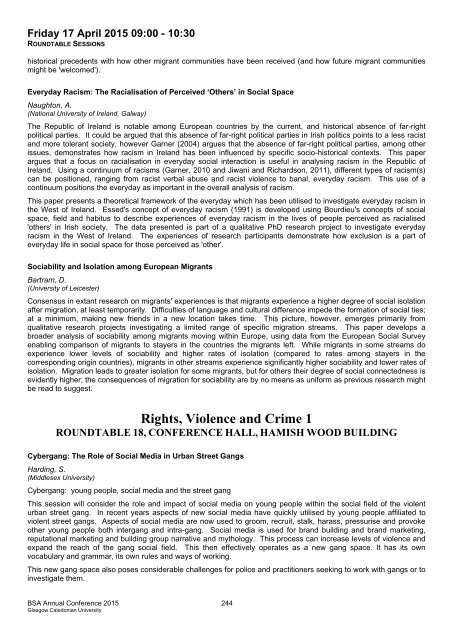Programme full
Programme full
Programme full
You also want an ePaper? Increase the reach of your titles
YUMPU automatically turns print PDFs into web optimized ePapers that Google loves.
Friday 17 April 2015 09:00 - 10:30<br />
ROUNDTABLE SESSIONS<br />
historical precedents with how other migrant communities have been received (and how future migrant communities<br />
might be 'welcomed').<br />
Everyday Racism: The Racialisation of Perceived ‘Others’ in Social Space<br />
Naughton, A.<br />
(National University of Ireland, Galway)<br />
The Republic of Ireland is notable among European countries by the current, and historical absence of far-right<br />
political parties. It could be argued that this absence of far-right political parties in Irish politics points to a less racist<br />
and more tolerant society, however Garner (2004) argues that the absence of far-right political parties, among other<br />
issues, demonstrates how racism in Ireland has been influenced by specific socio-historical contexts. This paper<br />
argues that a focus on racialisation in everyday social interaction is useful in analysing racism in the Republic of<br />
Ireland. Using a continuum of racisms (Garner, 2010 and Jiwani and Richardson, 2011), different types of racism(s)<br />
can be positioned, ranging from racist verbal abuse and racist violence to banal, everyday racism. This use of a<br />
continuum positions the everyday as important in the overall analysis of racism.<br />
This paper presents a theoretical framework of the everyday which has been utilised to investigate everyday racism in<br />
the West of Ireland. Essed's concept of everyday racism (1991) is developed using Bourdieu's concepts of social<br />
space, field and habitus to describe experiences of everyday racism in the lives of people perceived as racialised<br />
'others' in Irish society. The data presented is part of a qualitative PhD research project to investigate everyday<br />
racism in the West of Ireland. The experiences of research participants demonstrate how exclusion is a part of<br />
everyday life in social space for those perceived as 'other'.<br />
Sociability and Isolation among European Migrants<br />
Bartram, D.<br />
(University of Leicester)<br />
Consensus in extant research on migrants' experiences is that migrants experience a higher degree of social isolation<br />
after migration, at least temporarily. Difficulties of language and cultural difference impede the formation of social ties;<br />
at a minimum, making new friends in a new location takes time. This picture, however, emerges primarily from<br />
qualitative research projects investigating a limited range of specific migration streams. This paper develops a<br />
broader analysis of sociability among migrants moving within Europe, using data from the European Social Survey<br />
enabling comparison of migrants to stayers in the countries the migrants left. While migrants in some streams do<br />
experience lower levels of sociability and higher rates of isolation (compared to rates among stayers in the<br />
corresponding origin countries), migrants in other streams experience significantly higher sociability and lower rates of<br />
isolation. Migration leads to greater isolation for some migrants, but for others their degree of social connectedness is<br />
evidently higher; the consequences of migration for sociability are by no means as uniform as previous research might<br />
be read to suggest.<br />
Rights, Violence and Crime 1<br />
ROUNDTABLE 18, CONFERENCE HALL, HAMISH WOOD BUILDING<br />
Cybergang: The Role of Social Media in Urban Street Gangs<br />
Harding, S.<br />
(Middlesex University)<br />
Cybergang: young people, social media and the street gang<br />
This session will consider the role and impact of social media on young people within the social field of the violent<br />
urban street gang. In recent years aspects of new social media have quickly utilised by young people affiliated to<br />
violent street gangs. Aspects of social media are now used to groom, recruit, stalk, harass, pressurise and provoke<br />
other young people both intergang and intra-gang. Social media is used for brand building and brand marketing,<br />
reputational marketing and building group narrative and mythology. This process can increase levels of violence and<br />
expand the reach of the gang social field. This then effectively operates as a new gang space. It has its own<br />
vocabulary and grammar, its own rules and ways of working.<br />
This new gang space also poses considerable challenges for police and practitioners seeking to work with gangs or to<br />
investigate them.<br />
BSA Annual Conference 2015 244<br />
Glasgow Caledonian University


